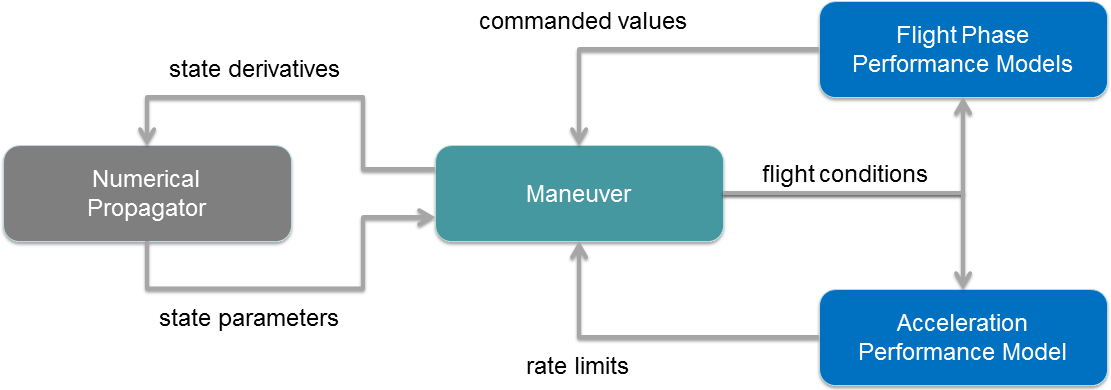Aircraft Propagation |
The Aircraft Propagation Library provides the capability to model an aircraft's motion through different maneuvers. The motion is governed by performance models corresponding to the various phases of flight of an aircraft. Additionally, aerodynamic and propulsion models which define the flight characteristics of the aircraft may be used to define the orientation and fuel flow of the aircraft under certain flight conditions. Flight parameters can be determined from the resulting motion to assess whether the overall objectives of the flight are achieved.
The library makes use of the Numerical Propagation and Segment Propagation capabilities in DME Component Libraries to provide a flexible and extensible mechanism for problem formulation and solution. A NumericalPropagatorSegment allows the parameters defining a single maneuver to be defined and propagated until one of several StoppingConditions are triggered. By assembling a series of propagation segments into a SegmentList, an entire sequence of procedures defining an aircraft's mission can be configured and propagated.
The functionality described in this topic requires a license for the Aircraft Propagation Library. |
Conceptually, the following diagram captures the interaction between the numerical propagation component of the API and the maneuver and performance models.
Principally, the role of the numerical propagator is to integrate the derivatives of the state elements provided by the maneuver and supply the integrated state elements back to the maneuver. Based on the objectives of the maneuver (attain a cruising flight condition, for example) the performance model for the appropriate phase of flight supplies the commanded values (for example, the desired cruise airspeed). The maneuver then determines the derivatives of the state parameters to achieve the commanded values. Rate limits are supplied by the acceleration performance model which the maneuver may use to govern the derivatives supplied to the numerical integration process.

The following topics provide the details necessary to configure a maneuver and propagate an aircraft's motion accordingly.
Topic | Description |
|---|---|
The flight objectives of an aircraft over a discrete portion of its flight are captured in a Maneuver. The maneuver may constitute various aspects of the aircraft's motion including climbing, turning, accelerating, rolling, etc. Additionally, many maneuvers may define the motion of the aircraft with respect to either the static local atmosphere or, with wind, the moving local atmosphere. | |
Performance models are used to define the behavior of the aircraft in flight. By specifying performance models to use with each maneuver, you can vary the manner in which the aircraft performs based on the priorities of the mission. | |
Simple fixed-wing aerodynamic and propulsion models may be used along with an assumption of coordinated flight, using SimpleFixedWingCoordinatedFlight to assess the necessary aircraft orientation, aerodynamic, and propulsion parameters required to execute the track and profile motion established by the maneuver. | |
A complete code example is provided of everything a user needs to set up performance models and maneuvers; configure propagators, segments, and stopping conditions; and generate data in a form that can be used by other libraries. For further details, see the Numerical Propagation and Segment Propagation topics. |